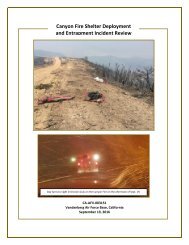Final Report to the Joint Fire Science Program
13-1-04-45_final_report
13-1-04-45_final_report
You also want an ePaper? Increase the reach of your titles
YUMPU automatically turns print PDFs into web optimized ePapers that Google loves.
Coop & Magee P-J Fuel Treatment Effects 12/31/2016<br />
following mastication treatments in more productive forest types (e.g., Stephens et al., 2012). We<br />
also found increases in herb and shrub cover as a function of time-since-treatment across our 11-<br />
year chronosequence. Similarly, Fornwalt et al. (2016) reported increases in grasses and forbs in<br />
mulched P-J woodlands continuing through at least 6-9 years post treatment.<br />
Three major shifts in vegetation composition associated with mastication treatments included 1)<br />
reduced cover by both piñon and juniper trees, 2) increases by a suite of shade-in<strong>to</strong>lerant, native<br />
grasses, and 3) a considerable expansion of weedy, non-native species. Each of <strong>the</strong>se shifts also<br />
showed relationships <strong>to</strong> measured climate variables across our study area. Though we did not<br />
find significant shifts in <strong>the</strong> relative proportions of piñon and juniper trees or seedlings in<br />
treatments vs. controls, <strong>the</strong> slight proportional decreases in piñon and increases in juniper are<br />
suggestive of longer-term changes reported by o<strong>the</strong>rs (Redmond et al., 2014; Schott and Pieper,<br />
1987) <strong>to</strong>wards increased juniper dominance following thinning. Masticated treatments in our<br />
study area did not yield changes <strong>to</strong> native species richness, in contrast with findings elsewhere<br />
(e.g., Fornwalt et al. 2016), though patterns of cover by <strong>the</strong>se species changed substantially. As<br />
has been found following P-J tree removal treatments elsewhere in <strong>the</strong> western U.S. (Fornwalt et<br />
al. 2016; Huffman et al., 2013; Ross et al., 2012; Roundy et al., 2014), we found substantial<br />
increases by a suite of native, perennial P-J unders<strong>to</strong>ry species. It might be expected that <strong>the</strong>se<br />
increases will persist until tree canopy cover rebounds. However, Schott and Pieper (1987)<br />
reported that grass cover fell back <strong>to</strong> pre-treatment levels in ca. 25 years following woodland<br />
removal treatments in New Mexico.<br />
Numerous o<strong>the</strong>r studies have reported increases in <strong>the</strong> abundance of non-native plant species,<br />
particularly cheatgrass, in P-J thinning treatments (Huffman et al., 2013; Owen et al., 2009;<br />
Redmond et al., 2014; Ross et al., 2012; Roundy et al., 2014; Stephens et al., 2016; Young et al.,<br />
2013). Patterns of occurrence and richness also point <strong>to</strong>ward large expansions in<strong>to</strong> mastication<br />
treatments, but additionally indicate a large regional species pool across both treated and<br />
untreated landscapes. Predictive models of non-native plant species occurrence suggest that<br />
increases are driven by canopy reduction, changes <strong>to</strong> <strong>the</strong> soil surface, and o<strong>the</strong>r unsampled<br />
fac<strong>to</strong>rs imparted by treatments. Models for cheatgrass alone and all non-native species <strong>to</strong>ge<strong>the</strong>r<br />
indicate strong negative associations with tree canopies, indicating that increased light<br />
availability (or perhaps below-ground resources such as moisture or nitrogen; Ross et al. 2012)<br />
enhanced colonization and growth in treatments. The effects of mastication debris piles in<br />
suppressing herbaceous plant growth have been reported in o<strong>the</strong>r forest types (Wolk and Rocca,<br />
2009), and appear <strong>to</strong> similarly reduce cheatgrass colonization in our study area. Three of <strong>the</strong> nonnative<br />
herbaceous species that increased in treatments, cheatgrass and <strong>the</strong> two tumbleweeds<br />
(prickly Russian thistle and tall tumblemustard) are expected <strong>to</strong> produce changes in fire behavior<br />
and post-fire recovery trajec<strong>to</strong>ries (Zouhar et al., 2008). In some systems, cheatgrass<br />
establishment and expansion alters fire cycles by changing fuel conditions and creating positive<br />
feedbacks that promote fur<strong>the</strong>r expansion (Brooks et al., 2004; D’An<strong>to</strong>nio and Vi<strong>to</strong>usek, 1992).<br />
Recent increases in burning in P-J systems in some settings has been attributed <strong>to</strong> cheatgrass<br />
expansion (Arendt and Baker, 2013; Miller and Tausch, 2001.<br />
14




